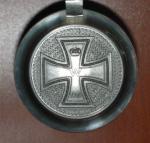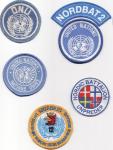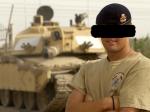-
Posts
429 -
Joined
-
Last visited
-
Days Won
1
Content Type
Profiles
Forums
Blogs
Gallery
Events
Store
Posts posted by GRA
-
-
-
Beer mug from the now disbanded PiBrig80 (the brigade itself is disbanded, but there could well be a surviving battalion left somewhere in the Bundeswehr order of battle), as I recall, the friend (a Hauptmann d R assigned to the brigade) who gave this mug to me also had another one with a slightly different motif - the bridge being black on a white background, which may have been designating a sub-unit (HQ Coy?).
/Jonas
Edit: Having searched the internet as well as given the old brain some exercise, I'm fairly certain that the mug insignia as well as the patch are of the brigade HQ Coy, and that the brigade insignia had the black bridge on white background.
0 -
Some patches with a Scandinavian connection: Starting with a patch worn by a Swede in the ONUC mission in Congo pre-1963 (the veteran I got it from were awarded the medal with the UNTSO-style ribbon with a "Congo" clasp, not the later green-white-blue ribbon). Then over to the ex-Yugoslavia missions of the 90's, the Nordbat 2 combination was worn by the Swedish contribution to UNPROFOR (it also included a Danish tank squadron), the UNPREDEP patch was issued to a Dane in the Scandinavian mission in Macedonia (which was actually considered the original Nordbat, hence Nordbat 2 in Bosnia). The Shirbrig patch has a Swedish connection because of the griffin (the regimental insignia of the South Scanian Regiment), and if Sweden didn't actually contribute with troops to Shirbrig, it could very well have been training in Southern Sweden. The bilingual UN patch is also Swedish in origin, but normally the patch with United Nations in English would be issued.
/Jonas
0 -
Anyone have any idea how he could have gotten a Swedish medal? Or am I simply reading wrong?
Some royal visit in either direction? Medals and orders tended to rain down on those involved. A German receiving a Swedish medal for gallantry (Tapperhet i fält) would be a tall order, but on the other hand, a Swede temporarily serving in a German unit (for example) during WW1 could very well be decorated with a Swedish gallantry medal despite the fact that Sweden were at the time strictly neutral and a non-combattant nation. An Order of the Sword wouldn't require combat service (or at least not involving gallantry), so I think it could be awarded in connection with, let's say, a royal visit.
/Jonas
0 -
-
Hello Christer!
Line infantry (or the Guards) by the look of the sabre pattern, and they brought at least one officer with them (the captain in the middle of the front row). Any idea which unit, or could it be a SNCO school "on tour"? Or could it be a German visit to Sweden even? It seems a bit unlikely to send a group of NCOs to another country at war, as far as I know, the Swedes participating on either side in WW1 did it as individuals (but then again, visiting and participating are two totally different activities).
/Jonas
0 -
Thanks Hugh! As I mentioned, I'm no oracle at this, and some of the deeper details as to entitlement to a ribbon device are still fuzzy to me. One learns something new each day in this hobby!
/Jonas
0 -
The motto always assumed "the cyclops position" whenever we donned headsets.
Makes sense, I never experienced it myself though, since I never served on armoured vehicles (and personal headsets for troopers on foot didn't exist in the Swedish army back in my time).
/Jonas
0 -
Hello Ulsterman!
Wouldn't there be some campaign stars / arrowheads or some such on the European Campaign ribbon? I assume that the colonel ought to have at least a campaign star or two, since he also got a Bronze Star, which I believe is awarded for "hands-on service" and not for mere paper pushing at HQ. Which is the correct order of wear for the pre-1941 service, US service and the various campaign medals? What are the two ribbons missing (I assume his ribbon bar is a "2-3-3")?
/Jonas
0 -
Hello Dave!
I fully agree, we did the same in my regiment, somehow beret badges tends to crawl towards the ear at the same rate as the regulations gets older...
 On the other hand, I've on occasion seen beret badges (including mottoes!) worn bang in the middle of the forehead too.
On the other hand, I've on occasion seen beret badges (including mottoes!) worn bang in the middle of the forehead too./Jonas
0 -
-
Hello Christer!
If someone knows when the Victory medal and the Army of Occupation Medal were first issued, you might be able to get an earliest date of this photo.
/Jonas
0 -
Hello Christer!
I'm not 100% certain, but I think he belongs to SHAEF (Supreme HQ in Europe) according to the patch, he was a career officer and in the army before the war (the light-coloured ribbon next to his index finger, you had to be serving on Dec. 7th, 1941 to get one), the top ribbons I believe are the Legion of Merit and the Bronze Star. It has to be a post-war photo since he's wearing the Victory Medal (2nd last) and the Army of Occupation Medal (last), and somewhere he ought to have the campaign medal for Europe (probably under his hand). The stripes I think denote 6 x 0,5 year of overseas service. By his rank and age, I'd say he went to war heading a squadron-sized unit (~battalion), or already was assigned to a higher HQ. I hope I have helped you some, I'm not 100% on this, but I'm sure there's someone on the forum who can provide more accurate information. By the way, this man is probably possible to ID, there cannot have been many of his rank and branch around, and he might even have been made general before retiring.
/Jonas
0 -
On amalgamation the 16/5L were infuriated that they had to discard their badge and wear the 17/21L badge, which, by the way, is referred to as "The Motto" and NEVER, EVER the "Badge".
Hello Dave!
What was the 17th/21st share of the badge designs contra 16th/5th upon amalgamation? Was there anything to perpetuate the 21st at all in the way of badges after the amalgamations, or was it essentially 17th patterns all the way through 17th/21st to QRL?
/Jonas
0 -
0
-
It seems like the skull and bones tradition started with the countries new to the hussar tradition, the Hungarians seemed not to need it - they already had a reputation! And to turn back to the original topic, one can understand that the skull and bones of the 17th Light Dragoons has survived two amalgamations, I wouldn't be surprised if the 21st Lancers as well as the 16th/5th Lancers respectively agreed unanimously on the motto as a suitable adornment in their caps. Robin, thank you for showing your "side-collection"!
/Jonas
0 -
Various countries used the skull and bones badge way back, but I think the Prussians were the first to really 'popularise' it.............i.e. others (including the English) copied it from the Ruesch and Belling outfits, with whom they had come into contact during The Seven Years War.
It makes sense, I somehow can't see that a "national Swedish" unit would go skull and bones - there has to have been influences, and I'm willing to bet that those Swedish hussars were, well, just Swedish by name (the unit from the Thirty-years War was from the Baltic region if I recall correctly). The Ruesch regiment (5th hussars) wore skulls and bones in the 1740s, and the Belling regiment were about contemporary with both the 17th (or, actually, 18th) Light Dragoons and the Swedish hussars, give or take a year or so. Robin, what's your take on the commemoration of Col Hale's friend Gen Wolfe KIA thus a skull and bones badge for Hale's newly raised regiment? Is that just a good story or the real reason?
/Jonas
0 -
Jonas - who first used the skull and crossbones ? Was it the Polish Cavalry - for many years they were the best in Europe and twice turned back the Turks. Thinking about it, I don't think I've seen who was credited with first use.
I wish I knew... Around the time of Colonel Hale raising the future 17th Light Dragoons there were also Swedish hussar units with the skull and bones as their cap badge (incidentally, a certain Blücher of later Waterloo fame somehow got enlisted with the Swedish hussars while still in his early teens!). There was also a Swedish unit in the Thirty-years War which had skulls on their standards, but this was way before the use of cap badges as such. I don't know if and when the Poles may have used skulls and bones as symbols. My opinion is that it is way too powerful a symbol to be neglected as a suitable badge for a military unit, so it may well have been used very early in the history of warfare (somewhere in a dusty corner in the back of my head I seem to recall something about an Italian unit, ca. Renaissance era, with some sort of skull with or without bones as their symbol, but I'm not sure). Robin might have the answer...
/Jonas
0 -
The 1841 badge posted above is strikingly similar to the two badges that started this thread!
I agree Robin, but I haven't got any idea at all as to when this badge went into use (if at all, there could be other sources / artistic freedom involved). As you might know, Richard Cannon started writing his series of "Historical Records" in 1838, the order was dated January 1st 1836 and signed by General Lord Hill, C-in-C.
Are you by any chance turning your home into an ossuary?

/Jonas
0 -
(Illustration from Cannon's "Historical Record of the Seventeenth Regiment of Light Dragoons - Lancers, London 1841.)
Am I missing anything (not the modern QRL stuff!!!)

Uhmm, yes! What about the early 17th Light Dragoons helmet badge, Col. Hale's choice, the two-piece one with the skull below the bones? Probably ridiculously expensive, but certainly standing out due to the inverted design!
/Jonas
0 -
the tradition-mad cavalry
Yup, we do that just to tease the rest of you!

@ Robin: Here's a link to some arm badges, there's one from the 17th/21st Lancers (but what date?) about half way down the page. I think Mervyn and Peter has a point, different era/uniform - different looking badge. I assume these badges might well be described in heraldic terms, which would open up for artistic freedom to a certain degree when ordering a new batch from a new manufacturer. And now I guess it's about time to get a good bashing from someone with a complete set of some old dusty regulations, as Mervyn predicted!
/Jonas
0 -
Hello Robin!
Not that I know whether different levels of rank would wear different designs or not, but it could also be a possibility that there's different designs between the units (17th Lancers, 17th/21st Lancers, Queen's Royal Lancers) or uniforms (Full Dress, No.1, No.2 etc.). The 17th/21st existed for ~70 years, with plenty of time to "improve" the badge, and the 17th were around for a lot longer time than that, while the QRL might still be enjoying the design of the 17th/21st. I just browsed through "The 17th/21st Lancers 1759-1993" (RLV ffrench Blake DSO), and found a quite blurry photo of a recent (well...) trumpet major wearing a badge on the chevrons, not above. Unfortunately the photo was taken from an angle and blurry, so it wasn't possible to compare with your badges. Have you tried asking their museum?
Just my 2 pennies...
/Jonas
0 -
Hello Farrar!
Regiments.org has been down for quite some time, but you can try this link to one of the last versions of that website before it disappeared. You might want to try a dedicated unit history though, since Regiments.org doesn't contain any detailed information as to which battalions went where in this case. The Royal fusiliers in the great war might provide some more detailed information on the Royal Fusiliers.
/Jonas
0 -
Jonas......
There were Irish, Dutch, German and American units that fought with the Boers against the British.....
Mike
I was just surprised that there was a whole Scandinavian unit organised, I thought that any Scandinavian contribution would have amounted to the occasional "tourist", and a handful of individual "thrill seekers" fighting as individuals for one or the other side.
/Jonas
0












Pionierbrigade 80
in Germany: Post 1945: Bundesrepublik & DDR
Posted · Edited by GRA
And finally, the brigade HQ Coy patch worn on the field uniform, attached with velcro.